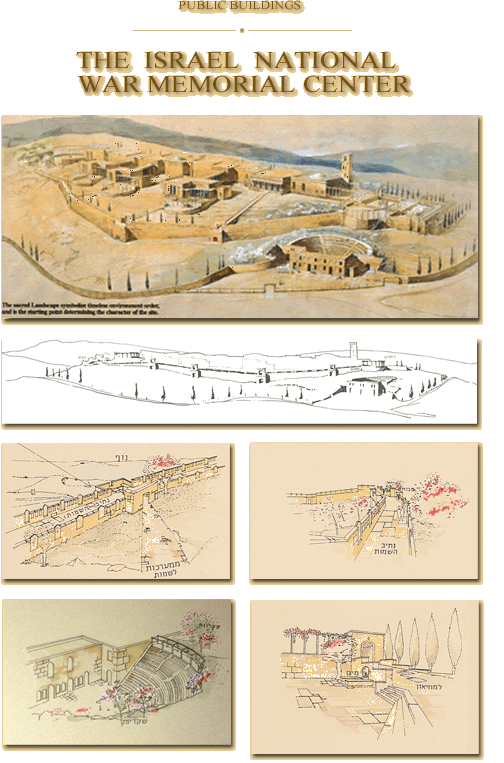|
Competition Entry - 1995
Location: Mount Eitan Jerusalem
Client: Har Eitan Society
Publications
about

The Israeli National War Memorial Center was to include:
- A Memorial Center commemorating all the soldiers
fallen in Israel's wars and military campaigns since the beginning of
the 20 th century.
- A museum complex presenting the history of the
Israel Defense Forces (IDF) and the struggle of Israeli society to
survive in the Land of Israel, from the earliest Zionist settlements to
the present day.
Wars, warriors and fallen warriors are an inseparable
part of the daily existence and reality, personal and collective, in
Israel.
In Israel the army is regarded as “the people’s
army”, representing the individual and the society as a
whole.
Since architecture reflects values, human values can
generate humane architecture.
Therefore it seems to me that projects related to military matters need
not necessarily be forceful.
The construction of a national center is in itself an
act loaded with symbolism, much more so when it is designed to
commemorate the human and personal facet of the warrior. Such a humane
message can be conveyed through a direct emotional experience created
by the linkage between man and place. I believe that the architectural
order I proposed has the power to do so.
The particular design proposal for the site was tightly
linked to the spiritual, cultural and physical forces of Mount Eitan.
The 40,000 square meters was planned as a linear
structure, composed of an identified complex of separate buildings,
organically integrated in the landscape, each corresponding to a
particular function as dictated by the program.
The site’s focal points are:
a. ”The Path of the Names”
which runs in the form of a wall along the periphery of the site,
visible from every point on the site.
Every fallen soldier has an individual corner along the path, where his
name is carved.
The wall blends gently with the landscape, a gentleness that expresses
the humanity of the fallen soldiers.
The path of names marks the border of the site.
It is an end and a beginning.
Where the path of names interacts with the lanes
coming from the pavilions exhibiting Israel’s battles,
movement slows down. Here there are sitting corners, facing the
scenery, for here time stands still.
b. ” The Lane of
Time” forms the backbone of the site, along which
are situated the galleries exhibiting IDF values, and from which fork
the pavilions exhibiting the wars and battles. It nourishes on the
legacy of the waves of immigrants whose story is exhibited in pavilions
along the lane, that came here since the early 20 th century being the
central force that formed and generated the lane of time. Much
like the Panathenaic way in ancient Athens that
led from the city gate to the Acropolis, where the procession of masses
of people who gathered on that way became the central force in the
creation of the urban development of Athens.
The lane of time ends at the Olive grove (the
symbol of peace). That grove symbolically forms an intersection between
the water (symbolizing life) coming from the well, and the path
of the names.
The building materials blend the traditional with the
contemporary. The building stones are the kind found at archeological
sites and used in monasteries in the area. The water and the orchards
are the link to tradition and to the physical and cultural roots of the
land of Israel.
|
![]()
